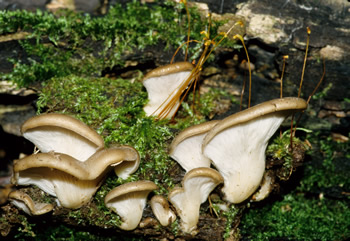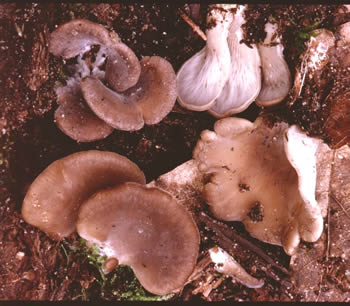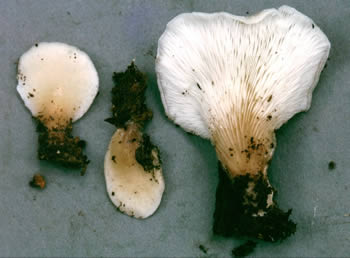Hohenbuehelia petaloides
Scientific name: Hohenbuehelia petaloides
(Bulliard:Fries)
Schulzer
Derivation of name: petal- means "petal" or "leaf" in
reference to the elongated petal-like appearance of
these mushrooms.
Synonyms: Pleurotus petaloides (Bull.) Quel.
Common name(s): Leaflike
oyster; shoehorn oyster.
Phylum: Basidiomycota
Order: Agaricales
Family: Pleurotaceae
Occurrence on wood substrate: Saprobic; solitary or in
clusters around stumps or woody debris, often on buried
wood; June through September.
Dimensions: Caps up to 10 cm wide; stipes are
very
short (1-4 cm) or nearly absent and continuous with the
cap.
Cap: Fan-shaped to shoehorn-shaped to deeply
funnel-shaped; brownish or paler; with a rubbery,
tougher
texture due a gelatinous layer below the
cuticle; smooth to minutely hairy; sometimes with a
whitish bloom when young.
Gills: Decurrent to base of stalk; crowded and narrow;
whitish to grayish; margins may be
finely fringed (use
hand lens).
Spore print: White
Stipe: Lateral, stubby, hairy, whitish.
Veil: Absent.
Edibility: Edible.
Comments: As with Pleurotus species, Hohenbuehelia
species supplement their
diet by capturing nematodes
their hypahe encounter in the rotten wood.
Confident identification of closely related Hohenbuehelia
species often requires examination of microscopic
characteristics.
More information at MushroomExpert.com:
More information at TomVolkFungi.net:

Figure 1. Brownish caps and whitish gills of shoehorn
oyster, Hohenbuehelia petaloides.
Photo © John Plischke III.

Figure 2. Fan-shaped to shoehorn-shaped caps with
lateral stipes or stipes nearly absent.
Photo © Steve Nelsen.

Figure
3. Note the whitish bloom on the cap and the
decurrent gills.
Photo © Steve Nelsen.